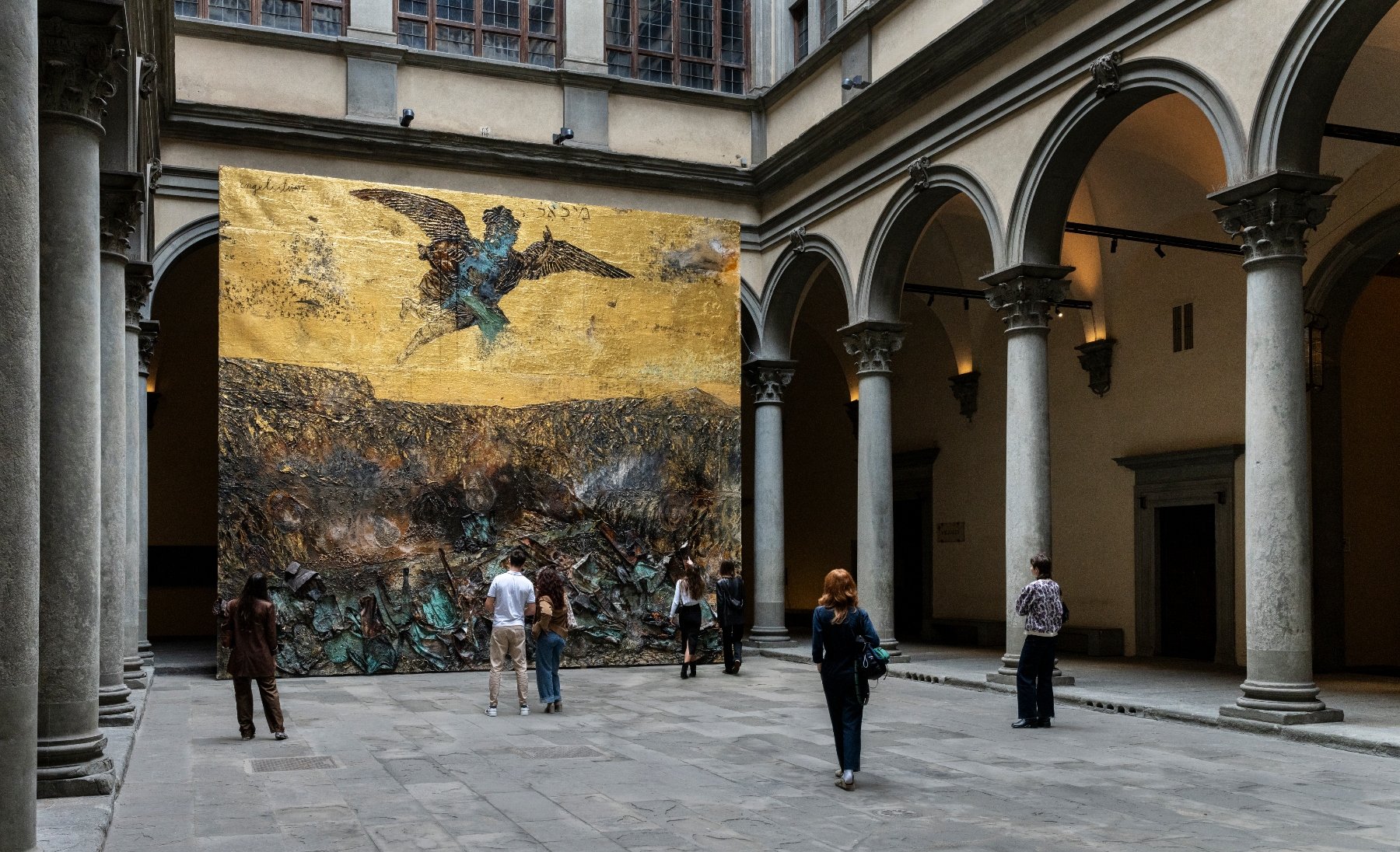
Right now, a room in a stately Florentine palazzo is filled wall-to-wall with gleaming gold. But this isn’t yet another ornate private chapel patronized by a powerful mercantile family during the early Renaissance. Rather, these paintings, crammed together in a salon-style hang that even covers the ceiling, are part of major exhibition of new and older works by Anselm Kiefer at the Palazzo Strozzi, on view through July 21.
Nevertheless, these works may well inspire visitors to contemplate a higher, spiritual realm. The German artist is one of the most celebrated of his generation for his ability to take epic themes of history, memory, philosophy, and myth, and not merely depict but actually materialize them on canvas in an act that has been described as alchemy.
Installation view of “Anselm Kiefer: Fallen Angels.” Photo: Ela Bialkowska, OKNO Studio Ⓒ Anselm Kiefer.
The show’s starting point is Engelssturz (Fall of the Angel) (2022-23), which is situated in the palazzo’s central courtyard and depicts a passage from the Book of Revelation in which the archangel Michael, representing Good, battles against rebel angels that represent Evil. This eternal theme, as relevant today as it was in Renaissance society, runs central to the entire exhibition. It invites open-ended reflection about ourselves, humanity at large, our shared past, and the kind of society that we hope to live in.
“The concepts of the Holy Spirit and the Trinity continue to captivate me,” Kiefer said a recent conversation with Palazzo Strozzi’s director Arturo Galansino. “Theodicy, a part of philosophy that examines the relationship between divine justice and the presence of evil in the world, is particularly intriguing. It asserts that God is inherently good, and yet the world is plagued by evil. Theologians argue that this coexistence is a result of the presence of free will.
“When I first visited Florence, approximately at the age of seventeen—I must consult my diary, its writing is a lifelong practice of mine—I recall making notes about Palazzo Strozzi,” Kiefer told Galansino, reflecting on his lifelong relationship to the venue. “The reason remains elusive, but perhaps its ‘minimal’ allure rendered it one of my favorite edifices in the world.”
Installation view of “Anselm Kiefer: Fallen Angels.” Photo: Ela Bialkowska, OKNO Studio Ⓒ Anselm Kiefer.
Perhaps appropriately for works containing such layered references to literature, poetry, philosophy, religious texts, and ancient myths, Kiefer’s paintings are densely stratified, almost morphing into relief sculptures. Raw materials like seeds, sand, ashes, onto great hefts of lead, are used for their evocative rather than descriptive powers. In this way, the pieces take on a monumental presence despite being affixed to a wall.
“I perceive a painting as an ongoing process rather than a finished product,” Kiefer told Galansino. “I keep paintings for years, occasionally revisiting and reworking pieces dating as far back as 1969.”
He later added, “for me, painting is not merely about creating an artwork, but rather, it symbolizes my personal struggle.”
Installation view of “Anselm Kiefer: Fallen Angels.” Photo: Ela Bialkowska, OKNO Studio Ⓒ Anselm Kiefer.
Of the inscriptions that sometimes adorn his work, Kiefer said, “I have always had a strong affinity for writing, literature, and poetry. The words I choose to inscribe have, for me, a certain aura about them.”
“Inscriptions can serve as a form of commentary, sometimes aligned with the painting, and sometimes in contrast to it,” he added.
Installation view of “Anselm Kiefer: Fallen Angels.” Photo: Ela Bialkowska, OKNO Studio Ⓒ Anselm Kiefer.
The exhibition also contains lead-printed versions made in the 2000s of photographs taken in 1969 known as Kiefer’s “Heroic Symbols” series. The artist himself appears in the images performing what he has described as “occupations” in various locations across Europe. In one case, he donned the Nazi-era Wehrmacht officer uniform that once belonged to his father and made a provocative gesture reminiscent of the now taboo Sieg Heil salute. Kiefer has returned again and again to the weight of recent German history in his work.
Reflecting on contemporary conflicts, Kiefer told Galansino, “men are ill-conceived. Their actions often defy comprehension. They destroy themselves. Wars have persisted throughout history, spanning various regions.”
Installation view of “Anselm Kiefer: Fallen Angels.” Photo: Ela Bialkowska, OKNO Studio Ⓒ Anselm Kiefer.
Born in 1945 in the southern German town of Donaueschingen, Kiefer gained international renown in 1980 when he and George Baselitz represented West Germany at the 39th Venice Biennale. For the past three decades lived and worked in France. His work was recently the subject of Anselm, a 3D documentary by the German filmmaker Wim Wenders.
“Anselm Kiefer: Fallen Angels” is on view at Palazzo Strozzi in Florence, Italy until July 21, 2024.